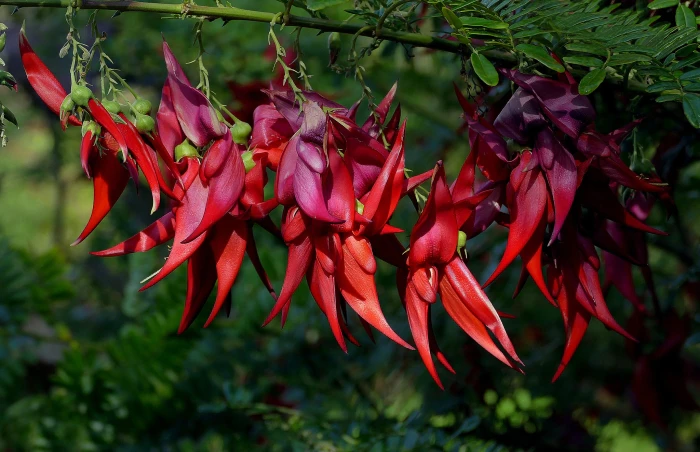Kaka Beak
(Clianthus puniceus)
Kaka Beak (Clianthus puniceus)
/
/

Bernard Spragg. NZ
CC0 1.0 Universal
Image By:
Bernard Spragg. NZ
Recorded By:
Copyright:
CC0 1.0 Universal
Copyright Notice:
Photo by: Bernard Spragg. NZ | License Type: CC0 1.0 Universal | License URL: https://creativecommons.org/licenses/by/2.0/ | Uploader: Bernard Spragg | Publisher: Flickr |





















Estimated Native Range
Climate Requirements for Madison, Mississippi
| This Plant | Your Site | Plant Suitability for Your Location | ||
|---|---|---|---|---|
| • Precipitation | 16" - 114" | 56" | Aquatic | Aquatic |
| • High Temp. | 61°F - 93°F | 92°F | Your summer temperatures are normal for this plant. | Excellent |
| • Low Temp. | 18°F - 65°F | 34°F | Your winter temperatures are normal for this plant | Excellent |
This plant should grow very well at your location without additional irrigation.
Summary
Clianthus puniceus, commonly known as Kaka Beak, is an evergreen shrub native to New Zealand, particularly found in open woodlands and along forest margins. It is one of two species of Clianthus, both of which are noted for their striking clusters of red flowers that resemble the beak of the kākā, a New Zealand parrot, hence the names parrot’s beak, parrot’s bill, and lobster claw. A variety with white to creamy colored flowers is also known. Clianthus puniceus typically grows to around 2 m (6 ft 7 in) high, with spreading branches. The leaf stalks can be up to 15 cm (6 in) long, bearing several pairs of small leaflets. The plant usually flowers from spring through to early summer, but in some climates, it can flower twice a year or even year-round. The flowers are quite showy and attract pollinators, including birds and bees.
Kaka Beak is valued for its ornamental flowers and is used in gardens for border planting or as a specimen shrub. It can also be trained against a wall due to its scandent habit. Gardeners appreciate its moderate maintenance requirements and ability to attract wildlife. It requires shelter from frosts and is not tolerant of heavy or waterlogged soils. In cultivation, it does best in full sun, with medium amounts of water, and in soils with medium or fast drainage. While it is not known for significant diseases or pests, root rot can occur in poorly drained soils.CC BY-SA 4.0
Kaka Beak is valued for its ornamental flowers and is used in gardens for border planting or as a specimen shrub. It can also be trained against a wall due to its scandent habit. Gardeners appreciate its moderate maintenance requirements and ability to attract wildlife. It requires shelter from frosts and is not tolerant of heavy or waterlogged soils. In cultivation, it does best in full sun, with medium amounts of water, and in soils with medium or fast drainage. While it is not known for significant diseases or pests, root rot can occur in poorly drained soils.CC BY-SA 4.0
Plant Description
- Plant Type: Shrub
- Height: 6-8 feet
- Width: 3-4 feet
- Growth Rate: Moderate
- Flower Color: Pink, Red
- Flowering Season: Spring, Summer
- Leaf Retention: Evergreen
Growth Requirements
- Sun: Full Sun
- Water: Medium
- Drainage: Medium, Fast
Common Uses
Bird Garden, Hummingbird Garden, Low Maintenance, Salt Tolerant, Showy Flowers
Natural Habitat
Native to open woodlands and forest margins in New Zealand
Other Names
Common Names: Glory-Pea, Glory Pea, Lobster Claw, Parrot’s Bill, Parrot-Beak, Red Kowhai, Parrot’s Beak
Scientific Names: Clianthus puniceus, Donia punicea, Clianthus puniceus var. puniceus
GBIF Accepted Name: Clianthus puniceus (G.Don) Sol. ex Lindl.